Cybersecurity Challenges in Digital Infrastructure

The digital world is getting more complex. Cybersecurity challenges in digital infrastructure are growing. Network security is now a top priority for businesses and governments.
They face tough cyber threats. These threats can harm entire economies. Recent data shows a rise in cyber vulnerabilities.
Almost 400 ways to improve cybersecurity have been found. But, 170 of these ideas are not being used. Ransomware attacks have jumped by 150% in a year.
This has caused big financial losses in many areas. Companies are under a lot of pressure to keep their digital assets safe. Small businesses are at high risk, with 43% of cyberattacks targeting them.
The damage from cyberattacks can be huge. Sixty percent of small companies might close within six months after a big cyber attack.
Table of Contents
- 1 Understanding the Economic Impact of Cybersecurity Breaches
- 2 The Evolution of Digital Infrastructure Threats
- 3 Core Principles of Information Asset Protection
- 4 Critical Infrastructure Vulnerability Assessment
- 5 Cybersecurity Challenges in Digital Infrastructure
- 6 State-Sponsored Cyber Threats and National Security
- 7 Malware and Ransomware: Modern Digital Weapons
- 8 Supply Chain Security in Digital Systems
- 9 The Role of Artificial Intelligence in Cybersecurity
- 10 Data Protection Strategies for Organizations
- 11 International Cooperation in Cyber Defense
- 12 Human Factor in Digital Security
- 13 Emerging Technologies and Security Implications
- 14 Regulatory Compliance and Security Standards
- 15 Conclusion
Key Takeaways
- Cybersecurity challenges are growing exponentially in complexity and scale
- Network security requires continuous adaptation and proactive strategies
- Small businesses are disproportionately at risk of cyber threats
- Unaddressed cybersecurity recommendations pose significant national risk
- Ransomware attacks represent a critical threat to organizational stability
Understanding the Economic Impact of Cybersecurity Breaches
Cybersecurity breaches are a big threat to the world’s economy. The way we handle money has changed a lot. Now, digital systems are at risk of being attacked by hackers, which can hurt a company’s money a lot.
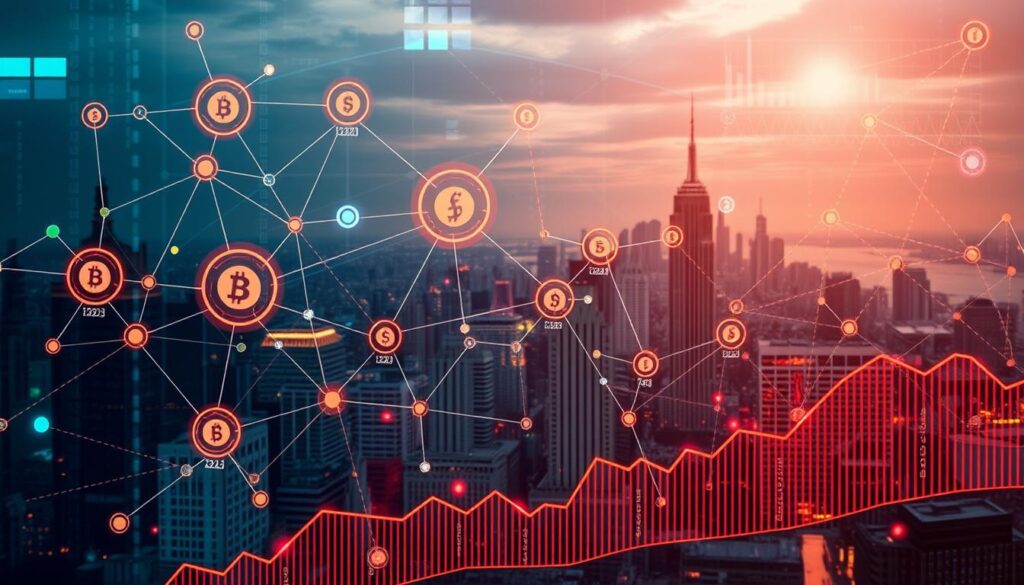
The damage from cybercrime is huge. In 2020, cyber attacks cost the world USD 945 billion. This is almost double what it was in 2018. It shows we really need to protect our data and systems.
Global Financial Losses from Cyber Attacks
Cyber attacks cause big problems for the economy. Here are some important facts:
- Total global cybercrime costs estimated at USD 4-6 trillion in 2020
- Approximately 4-6% of global GDP affected by technological asset security breaches
- 70% of security incidents financially motivated
- 80% of data breaches attributed to organized crime
Direct and Indirect Cost Analysis
| Cost Category | Estimated Impact |
|---|---|
| Immediate Financial Losses | USD 945 billion |
| Cybersecurity Spending | USD 145 billion (1.3% of global GDP) |
| Average Data Breach Cost | USD 392 million |
| Cyber Insurance Claims | Increased from USD 145,000 to USD 359,000 |
Impact on Developing Economies
Developing countries have big problems with cybersecurity. For example, the Bangladesh Bank heist in 2016 cost USD 81 million. This shows how vulnerable new digital systems are.
“Cybersecurity is no longer just a technological issue, but a critical economic imperative.” – Global Cybersecurity Expert
The Evolution of Digital Infrastructure Threats
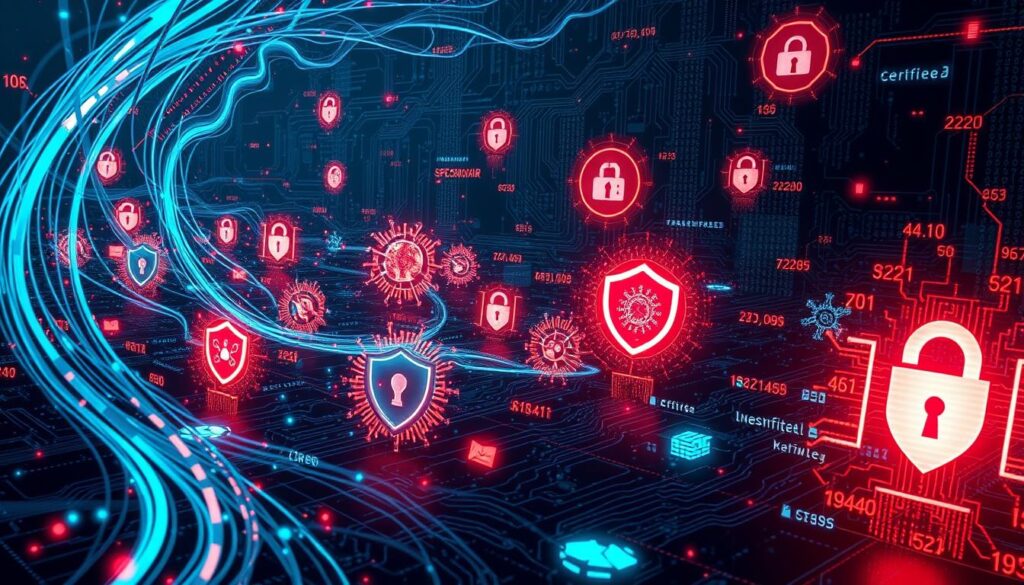
Digital threats have changed a lot in recent years. Now, cyber threats are a mix of smart attack plans that keep getting better. Companies need strong ways to handle these dangers in the digital world.
The world of cybersecurity has changed a lot because of new tech and smarter criminals. Attackers are now using many ways to get into digital systems. They are very good at it.
“Cybercrime is projected to cost the world $10.5 trillion annually by 2025, signaling a critical moment for global digital security.”
- Advanced Persistent Threats (APTs) show off complex ways to sneak in.
- Ransomware attacks have doubled, hitting important places.
- Weak spots in the supply chain keep putting networks at risk.
Some new threats to watch out for are:
| Threat Type | Primary Target | Potential Impact |
|---|---|---|
| IoT Vulnerabilities | Connected Devices | Big Network Problems |
| Cloud Security Gaps | Distributed Systems | Data Leaks |
| AI-Driven Malware | Adaptive Defense Systems | Smart Cyber Attacks |
It’s important to remember that cyber threats are always changing. The digital world keeps getting more complex. Companies need to stay ahead by using smart, flexible ways to manage risks.
Core Principles of Information Asset Protection
Digital systems face many security challenges. They need strong protection strategies. Organizations must protect their important information assets from cyber threats.
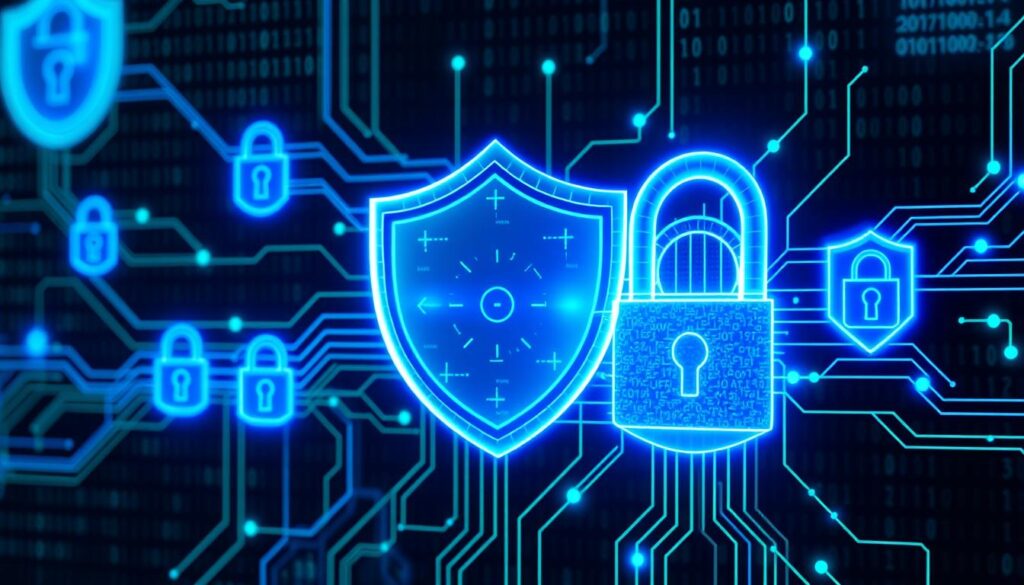
The CIA triad is key to information security. It includes confidentiality, integrity, and availability. These elements are the heart of good security policies and how to handle security incidents.
Confidentiality in Digital Systems
Keeping sensitive information safe needs many defenses. Important steps include:
- Using strong encryption
- Setting up good access controls
- Creating systems for who can do what
Integrity Preservation Methods
Keeping data safe means it stays the same and is trusted. Ways to do this include:
- Checking system integrity often
- Using cryptographic hashes
- Having secure backups and recovery plans
“The weakest link in cybersecurity is often human behavior, not technology.” – Cybersecurity Expert
Availability Maintenance Strategies
Keeping systems running is key for work to go smoothly. Important steps include:
- Designing systems with redundancy
- Using monitoring systems
- Having quick plans for when things go wrong
Recent numbers show how important protecting information is. In 2023, the average cost of a data breach was over $4 million. Companies lost about $1.1 million. Strong security policies can help avoid these big financial losses.
Critical Infrastructure Vulnerability Assessment

Critical infrastructure is facing big cybersecurity challenges today. Vulnerability assessment is key to protect important systems in many areas. Companies need strong access controls to avoid risks and stop unauthorized access.
“Cybersecurity is no longer an option, but a necessity for critical infrastructure protection” – Cybersecurity Expert
In 2023, 143 risk and vulnerability assessments were done in critical sectors. These showed big insights into cyber threats and system weaknesses.
Key Vulnerability Assessment Findings
- 11 out of 14 cyber threat actor tactics were mapped
- ‘Valid Accounts’ emerged as the most prominent access technique
- Attack paths typically involve multiple stages of system infiltration
The vulnerability assessment finds weak spots in digital systems. Cybersecurity experts work on many areas to protect systems, like:
- Initial access detection
- Credential management
- Network security architecture
| Infrastructure Sector | Vulnerability Rate | Key Risk Areas |
|---|---|---|
| Energy | 62% | Remote Device Access |
| Healthcare | 55% | Credential Exposure |
| Financial Services | 48% | Network Misconfigurations |
Companies can lower risks with multi-layered security strategies. This means using central cyber threat platforms, strong password rules, and secure multi-factor authentication.
The Infrastructure Resilience Planning Framework (IRPF) helps local, regional, and private groups improve their security plans. Keeping systems monitored and doing regular vulnerability checks is vital for digital infrastructure safety.
Cybersecurity Challenges in Digital Infrastructure
Digital infrastructure faces big cybersecurity challenges today. This is because our world is more connected than ever. Companies must deal with complex threats and protect their tech from smart attacks.
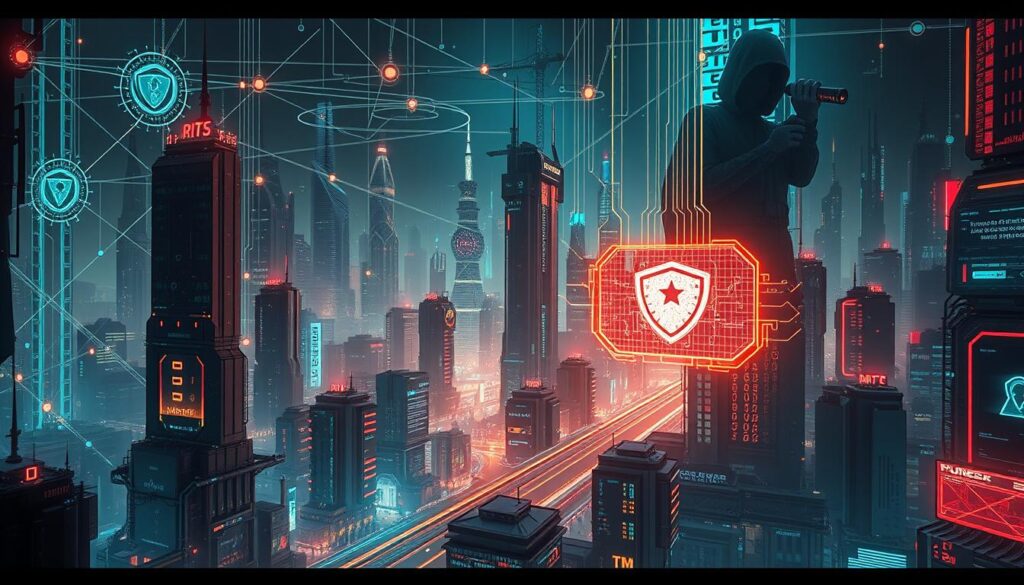
The digital world keeps changing, bringing new security risks. We need smart strategies and strong defenses to fight these threats.
Network Security Concerns
Modern networks face big security issues:
- Increasing complexity of digital systems
- Rapid technological transformations
- Expanding attack surfaces
“80% of security breaches involve compromised passwords, highlighting critical authentication vulnerabilities.”
Infrastructure Protection Measures
To keep things safe, we need strong protection plans:
- Implement multi-factor authentication
- Deploy advanced encryption technologies
- Develop thorough incident response plans
Emerging Security Threats
| Threat Category | Risk Level | Potential Impact |
|---|---|---|
| IoT Device Vulnerabilities | High | Potential Network Compromise |
| AI-Powered Attacks | Critical | Advanced Persistent Threats |
| Cloud Infrastructure Risks | Medium | Data Breach Possible |
Cybersecurity in digital infrastructure needs constant updates and smart monitoring. We must invest in the latest tech defenses.
Remember, cybersecurity is an ongoing effort, not just a one-time thing.
State-Sponsored Cyber Threats and National Security

State-sponsored cyber threats are a big problem for national security. Sophisticated actors from different countries are targeting our critical infrastructure. They aim to disrupt essential services and shake political stability.
“In the digital age, cyber warfare has become a primary battleground for geopolitical influence.” – Cybersecurity Expert
The cyber threat landscape is getting worse:
- Attack methods are getting more advanced
- Critical infrastructure is being targeted
- Technological weaknesses are being exploited
- There’s a risk of big societal disruptions
Recent numbers show how serious these threats are. Over 70% of cyberattacks are from outside actors, with state groups being a big part. The damage to the global economy from these attacks is in the trillions every year.
| Threat Category | Potential Impact | Risk Level |
|---|---|---|
| Infrastructure Attacks | Power Grid Disruption | High |
| Political Manipulation | Election Interference | Critical |
| Economic Espionage | Strategic Information Theft | Severe |
The U.S. government sees these cyber threats as a top national security issue. Two Presidential Executive Orders have been made to tackle these problems, focusing on critical infrastructure equipment.
Companies and governments need to invest in strong cybersecurity, training, and working together internationally. This is the only way to fight these growing threats.
Malware and Ransomware: Modern Digital Weapons
The digital world is facing new threats that can harm organizations and systems. Malware and ransomware are powerful tools that can cause a lot of damage.
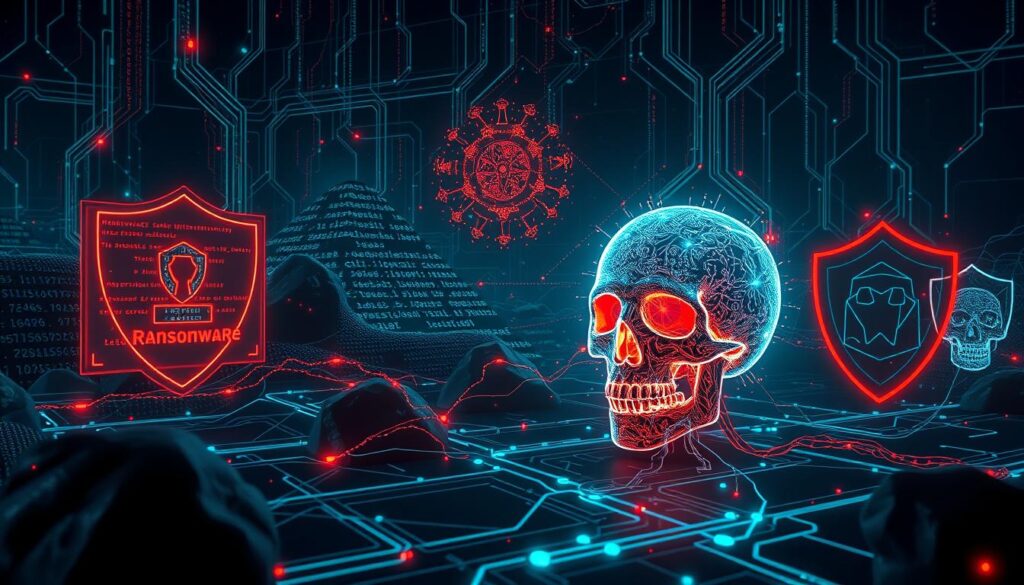
Cyber attacks are getting more complex. In 2023, ransomware attacks rose by 13%. These threats can weaken an organization’s data protection.
Types of Malicious Software
There are many types of harmful software:
- Viruses that spread and copy themselves
- Trojans that look like safe software
- Ransomware that locks systems
- Spyware that steals personal info
- Worms that move fast through networks
Defense Mechanisms Against Malware
To fight malware, we need strong defenses:
- Use advanced tools to analyze behavior
- Set up systems that learn from data
- Test files in safe environments
- Keep systems updated
- Train staff on security
Incident Response Protocols
“Preparation is the key to mitigating cyber threats before they escalate.”
Companies need to have plans ready for when attacks happen. These plans should help find and fix problems fast. In 2023, the FBI got over 2,500 ransomware complaints, with losses over $34 million.
To keep digital spaces safe, we must be proactive. We need to protect our systems from new and old malware threats.
Supply Chain Security in Digital Systems
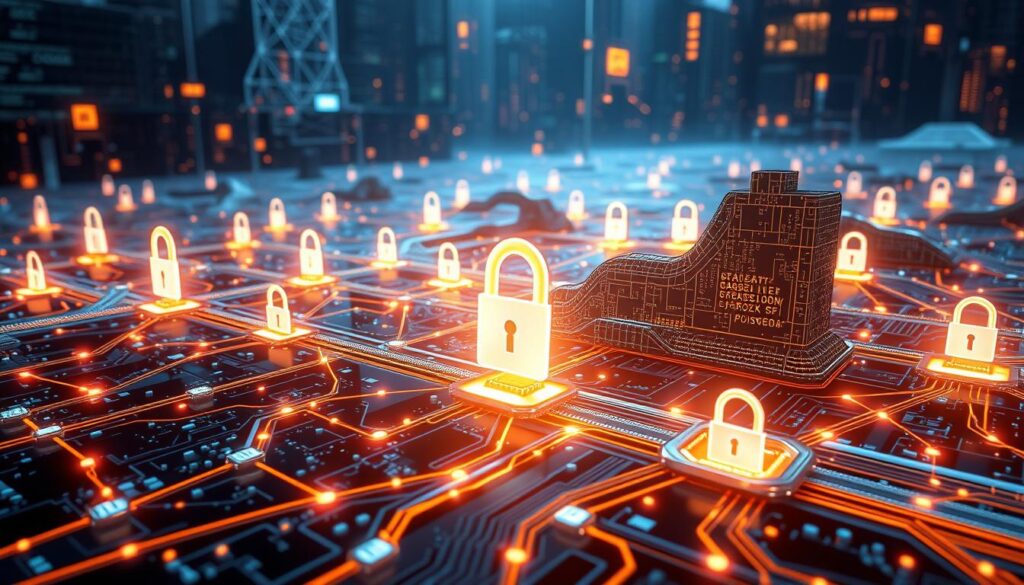
Digital systems face big challenges in keeping networks safe and managing risks. Modern supply chains are complex and have many weak spots for cyber threats. Recent studies show scary numbers about these vulnerabilities that need quick action.
“Supply chain cyber-attacks have quadrupled in the last four years, posing a major threat to security.” – Cybersecurity Experts
Companies need strong plans to safeguard their digital worlds. Important steps include:
- Checking vendors for risks
- Using secure software development
- Implementing advanced hardware checks
- Keeping an eye on third-party connections
Some shocking facts highlight the need for better supply chain security:
- 77% of companies don’t have a plan for when something goes wrong
- 60% of small businesses might close after a cyber attack
- The cost of a data breach averages $4.45 million
Managing risks well means being ahead of the game. Cybersecurity is now a must for businesses. Companies need to have solid plans to tackle risks in their whole digital supply chain.
The FBI talks about new, complex cyber attacks. These attacks can really hurt a company’s systems. Yet, only 30% of security leaders focus on making their systems safe and connected. This leaves many businesses open to big cyber dangers.
The Role of Artificial Intelligence in Cybersecurity
Artificial intelligence is changing how we fight cyber threats. AI has made it easier for companies to find, stop, and fix cyber attacks.
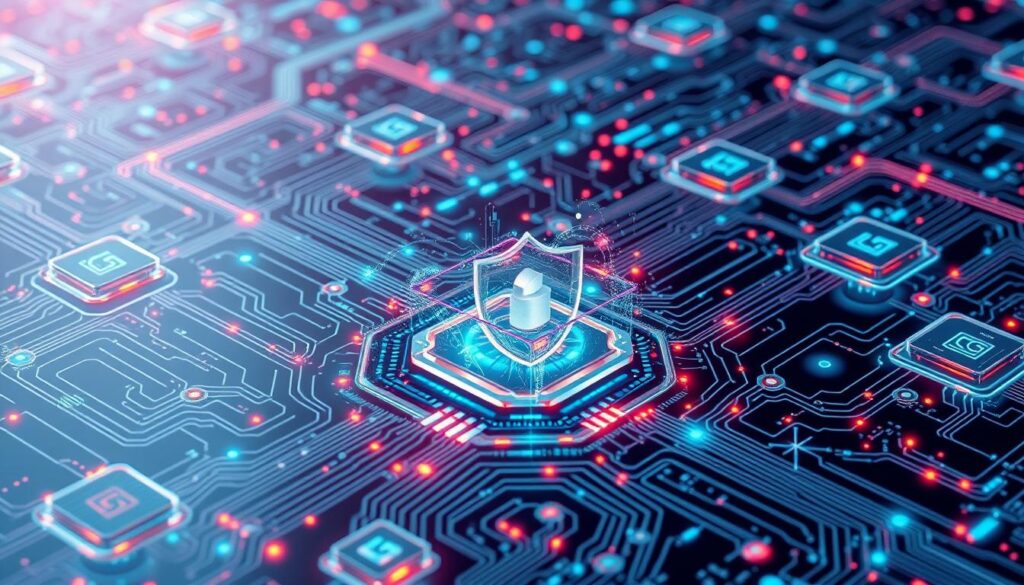
AI has brought big improvements in keeping systems safe. It helps companies make their security plans better with smart tech.
AI-Powered Threat Detection
AI has made finding threats much better. It does this by:
- Checking data fast for security breaches
- Finding network intrusions quickly
- Spotting patterns in cyber attacks
Machine Learning Applications
Machine learning is a big help in cybersecurity. It works with lots of data to get better over time. It can:
- Learn from past cyber attacks
- Reduce mistakes in security work
- Speed up fixing security problems
AI’s ability to spot complex attacks has changed how we defend against them.
Automated Response Systems
AI helps create systems that act fast to protect against threats. Machine learning algorithms help these systems react quickly to threats, making systems safer.
The future of keeping systems safe is in smart, learning technologies. They can stop cyber attacks before they start.
Data Protection Strategies for Organizations
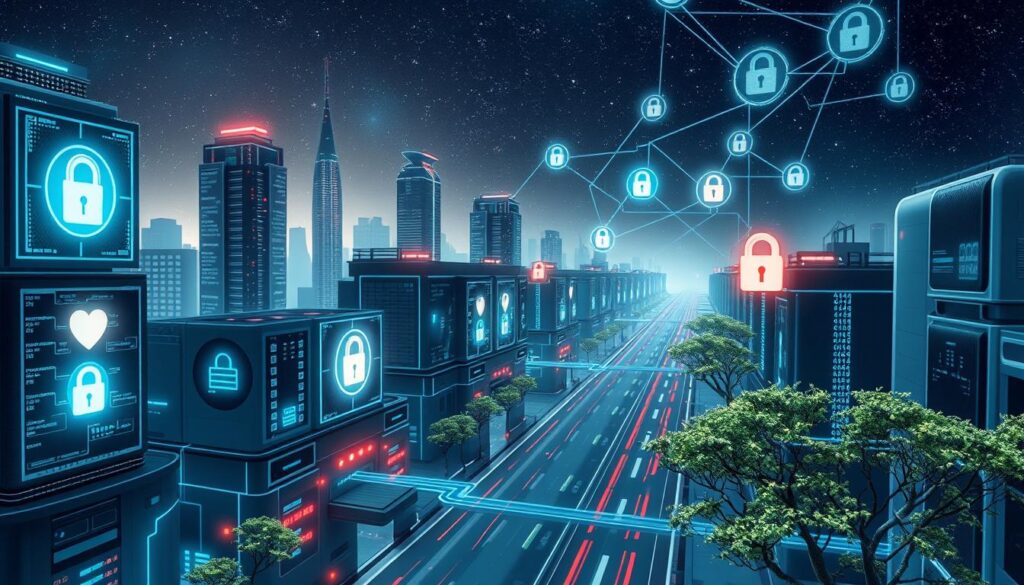
Organizations face big challenges in keeping their digital assets safe. Protecting data is now a top priority for companies facing new cyber threats. They need to use strong security measures to keep sensitive information safe in different tech environments.
Key data protection strategies include:
- Implementing robust access controls
- Developing strong encryption protocols
- Creating detailed data classification systems
- Setting up multi-layered security frameworks
“Effective data protection requires a holistic approach that integrates technology, processes, and human awareness.” – Cybersecurity Expert
Companies must see how vital data protection is to stop breaches. Access controls are key in keeping unauthorized access out. Studies show that using strong access controls can cut insider threats by about 55%.
| Protection Strategy | Implementation Rate | Risk Reduction |
|---|---|---|
| Multi-Factor Authentication | 78% | 65% |
| Role-Based Access Controls | 62% | 55% |
| Encryption Protocols | 85% | 70% |
The average cost of a data breach is over $4 million. This shows how much money bad security can cost. Companies must keep updating their data protection plans to handle new tech challenges and risks.
By 2024, 32% of U.S. companies will have Data Protection Officers. This shows how important data protection is becoming for businesses.
International Cooperation in Cyber Defense
The world faces a big challenge in cyber threats. We need to work together more than ever. Digital security is a global issue that needs a united effort to protect our important systems.

Cybersecurity policies are now focusing on teamwork across borders. Countries are creating detailed plans to tackle digital security problems together.
Global Security Standards
International groups are setting common security rules to fight cyber threats. Key efforts include:
- The UN Group of Government Experts (UN GGE) proposals for responsible cyberspace behavior
- EU cybersecurity laws like the NIS Directive
- International treaties such as the Budapest Convention on Cybercrime
Cross-Border Incident Response
Quick and united actions are key to lessening cyber attack damage. Many global exercises show how we can work together:
| Exercise | Participants | Purpose |
|---|---|---|
| Lockshield | 38 countries | Enhance joint cyber threat response |
Information Sharing Frameworks
Sharing information is key to digital unity. The United States is leading in international cybersecurity partnerships, focusing on:
- Promoting secure digital ecosystems
- Aligning governance approaches
- Strengthening cybersecurity capacities
“The next major international crisis could stem from weaponized ICT targeting critical infrastructure.” – Cybersecurity Experts
As cyber threats grow, working together is our best defense against digital disasters.
Human Factor in Digital Security

Digital security is a big challenge for humans. Even with the latest tech, people are the biggest risk. Studies show that up to 90% of data breaches happen because of human actions. This shows how key it is to understand how people act in risk management.
Cybersecurity experts know that mistakes by people can break even the best systems. Companies struggle to fight these risks with big plans:
- Regular cybersecurity training for everyone
- Strong security rules
- A culture that values security
- Overcoming psychological barriers to following security rules
“The weakest link in cybersecurity is always human judgment.” – Security Research Institute
Insider threats are a big problem, causing about 30% of data breaches. Companies can lower these risks by:
- Teaching employees well
- Training them to spot tricks
- Keeping security talks open and clear
- Using systems to watch for threats all the time
Putting money into security that focuses on people can cut down on problems by up to 50%. By knowing tech can’t protect everything, companies can make better plans. These plans should deal with the tricky parts of digital security that involve people.
Emerging Technologies and Security Implications
The digital world is changing fast, bringing new cybersecurity challenges. New technologies are changing how we protect digital spaces. They offer chances but also create complex problems.
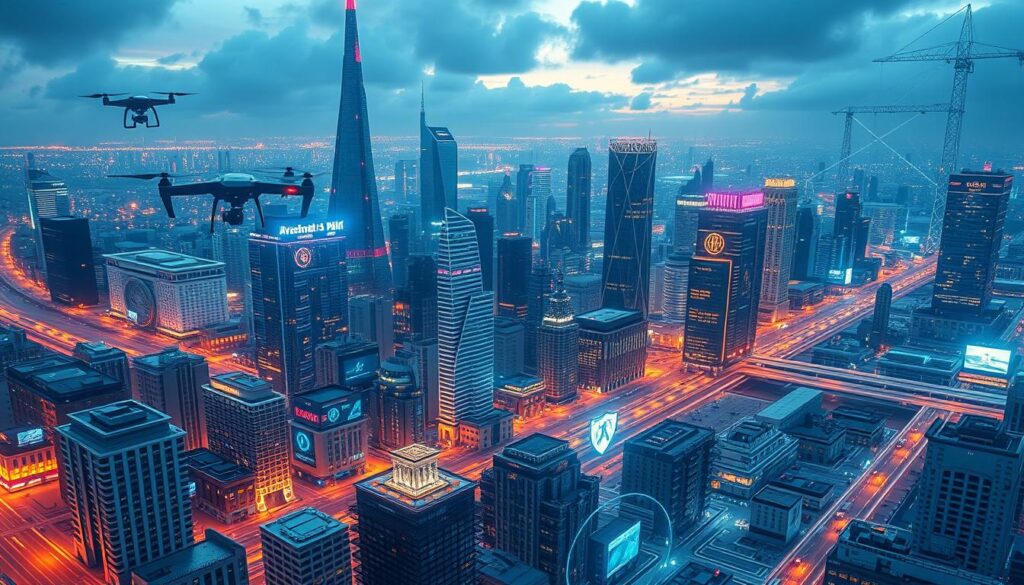
Digital changes bring new tech, but also big security worries. Companies must deal with complex systems while keeping their defenses strong.
IoT Security Challenges
IoT devices add many new risks to networks. Important security issues include:
- Device authentication protocols
- Data privacy protection
- Scalable security management
- Encryption of communication channels
Cloud Infrastructure Protection
Clouds bring unique security challenges that need strong security plans. Important points to consider are:
- Shared responsibility models
- Data residency regulations
- Cloud-native security approaches
- Advanced access control mechanisms
5G Network Security
5G networks bring new security issues. With speeds up to ten times faster, strong security measures are needed.
“The interconnected devices in a 5G network could massively increase the attack surface for hackers” – Cybersecurity Experts
For 5G, focus on network slicing, managing attack surfaces, and strong encryption. Being proactive is key to facing new tech risks.
Regulatory Compliance and Security Standards

The world of cybersecurity rules is changing fast in 2024. This brings big challenges for companies everywhere. Now, security plans and who gets to access what are key parts of being in line with the law.
New rules are changing how companies deal with digital safety:
- The Cyber Incident Reporting for Critical Infrastructure Act requires reporting big cyber attacks within 72 hours
- SEC says companies must tell the public about big cybersecurity risks fast
- New laws aim to keep electronic health info safe
“Compliance is no longer a checkbox exercise, but a strategic imperative for organizational resilience.” – Cybersecurity Expert
Companies face a complex web of rules. Now, they need to be ahead of the game with their security plans and strong access controls.
| Regulation | Primary Focus | Key Requirements |
|---|---|---|
| GDPR | Data Protection | Personal Data Handling |
| HIPAA | Healthcare Security | Protected Health Information |
| PCI DSS | Payment Security | Multi-Factor Authentication |
| NIS Directive | Critical Infrastructure | Incident Reporting |
The future of following the rules is about being flexible. Companies need to invest in strong security plans. These plans should do more than just follow the rules to really protect against cyber threats.
Conclusion
The digital world is changing fast, bringing new cybersecurity challenges. Research from 2019 to 2023 shows we need strong security plans. These plans must tackle the growing risks from cloud computing, IoT, and AI.
Old security methods won’t cut it anymore. We need to act fast against cybercrime. Using new tech like multi-factor authentication and encryption is key. Banks in Bahrain to Bangladesh show we must protect against identity theft and system breaches.
We need a layered defense strategy. This includes security checks, testing, training, and managing vendors. Keeping up with new tech and risks is essential for protecting our digital world.
Cybersecurity is a vital field that keeps evolving. We all must work together to build strong security systems. This will help us face the changing digital threats.






